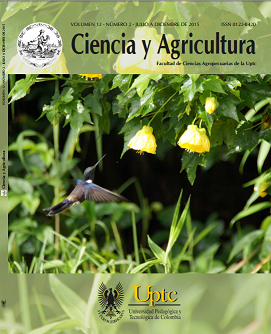Sensory evaluation of the wine grape Isabella (Vitis labrusca L.) hand crafted

Abstract
The production and consumption of wine in Colombia have increased over the last decade, especially with the red wines which are preferred by Colombians. Spite the few organoleptic characteristics of the grape Isabella (Vitis Iabrusca L.), it possesses intense flavors and aromas, plus its low sugar content and high concentration of acids, gives it the potential to be used in winemaking. The parameters involved in the sensory evaluation of the wines are the color, aroma and flavor and become sensations perceived in different areas of the tongue. The combination of these causes’s sensations are called wine texture. Sensory analysis of wines through tastings gives rise to a description, that although subjective, generates some impact on the market position ofthis drink. Descriptive tests are the most common and can express the different sensations of wine labeling them by a scale. The aim of this study was to evaluate the organoleptic quality through blind tasting, the artisan wine grape Isabella (Vitis Iabrusca L). We valued three crafted wines, two of them produced in the Pedagogical and Technological University of Colombia, and a third from the town of Cerrito, Valle del Cauca. The panel conformed by 20 tasters evaluated the wines according to the parameters set by the profile sheet given by the International Competition of Wines and Spirits (CINVE). The results showed significant differences between the Paradise wine Portal and the Semi-dry and semi-sweet UPTC wines. The results suggest that the Semi-dry wine obtained the lowest score ranking, as the best sensorial level. The Uptc wines obtained the lowest score, classified as the best in the sensory study.
Keywords
wine tasting, bouquet, organoleptic quality, red wine.
References
- Almanza, P.J.; Serrano P. y Fischer, G. Manual de viticultura tropical. Tunja: UPTC, 2012.
- Toro, N. y Suarez, L. Obtención y caracterización del aceite de las semillas de Vitis labrusca L. (uva Isabella) y evaluación de su actividad antioxidante. Pereira: Universidad Tecnológica de Pereira (en línea). 2012. Disponible en: http://repositorio.utp.edu.co/dspace/bitstream/11059/2943/1/66029T686.pdf.
- Almanza, P. Determinación del crecimiento y desarrollo del fruto de vid (Vitis viniferaL.) bajo condiciones de clima frío tropical. Tesis doctoral. Universidad Nacional de Colombia. 2011.
- Hernández, J.; Duran, D y Trujillo Y. Potencial fenólico de la variedad Isabella (Vitis labrusca L.) producida en Villa del Rosario-Norte de Santander-Colombia. Revista Bistua, 2010, 8(1): 88-96. Facultad de Ciencias Básicas Universidad de Pamplona. Pamplona-Colombia.
- Suescún, G. Utilización vinícola de la Opuntia dillenii. Revista Bistua, 2005, 3(1): 99-106. Facultad de Ciencias Básicas Universidad de Pamplona. Pamplona-Colombia.
- Millan, F; G. Serrano; I. Expósito. Resveratrol. Nuestros retos en el tratamiento antienvejecimiento. Dossier. 2008.
- Morina, A. y KongolI, R. Comparison of color parameters of red wines produced from albanian autochthonous grape varieties using trichromatic method. J. Agric. Sci., 2012, 11(4). 249-255. Universidad de Tirana. Albania.
- Peynaud, E. y Blouin, J. El gusto del vino. El gran libro de la degustación, 2ª. Ed. Madrid, España. 1999. 63 p.
- Catania, C. y S. Avagnina. La degustación. Curso superior de degustación de vinos. EEA Mendoza. INTA. 2007a. 26 p.
- Guirao, G.; Cano, V.; Rodríguez, M. y Hernández, J. Evaluación del análisis sensorial de vinos de Malvasía. Universidad de la Laguna. (en línea) 2007. Disponible en: http://www.fceye.ull.es/malvasia/doc/Trabajo14.pdf.
- Catania, C. y Avagnina, S. El análisis sensorial. Curso superior de degustación de vinos. EEA Mendoza. INTA. 2007b. 21p.
- Etaio, I. Análisis sensorial del vino tinto joven de Rioja Alaversa: Descripción y evaluación de la calidad. Tesis doctorales N.° 62. Universidad del País Vasco. (en línea) 2009. Disponible en: http://www.nasdap.ejgv.euskadi.net/r50-public2/es/contenidos/informe_estudio/tesis_doctorales/es_agripes/adjuntos/tesis_doctoral62.pdf.
- Concurso internacional de vinos y espirituosos (CINVE). Adaptado de la hoja de cata del concurso internacional de vinos y espirituosos del año 2011 (en línea) 2011. Disponible en: http://www.cinve.es. 10 p.
- Íñiguez, M.; Ortega, A.; Rosales, A.; Ayala, R. y Puras, P. Estudio del color de vinos tintos de D.O.C Rioja. Logroño. 1995. 45 p.
- Denis, J., y M.F. Denis. Vino argentino. Manual práctico. Albatros. 2008. 47 p.
- Gruettner, P.; Leiva, L. y Rodillo, M. Caracterización de los racimos, evaluación del potencial productivo y enológico de diferentes cvs. de Vitis vinifera L. en las comunas de Coelemu y Trehuaco. Pontificia Universidad Católica de Chile. (en línea) 2005. Disponible en: http://www.revistavirtualpro.com/files/TIE03_200712.pdf.
- Ferreira, V. La base química del aroma del vino: Un viaje analítico desde las moléculas hasta las sensaciones olfato-gustativas. Universidad de Zaragoza. Rev. Real Academia de Ciencias. 2007, 62: 7-36. Zaragoza.
- Phillip, H. Degustar el vino. El sabor del vino explicado. Albatros. Buenos Aires. Argentina. 2004. 191 p.